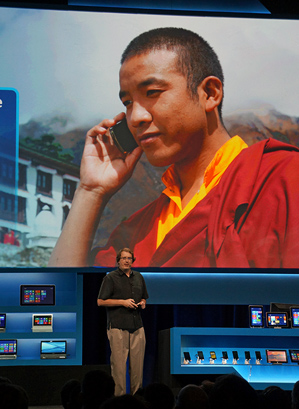Will the Developing World’s Smartphones Have Intel Inside?
Many predictions have been made about the impact smartphones could have on poor regions of the world—from improved health care to new modes of banking (see “Kenya’s Startup Boom”). Now the world’s largest chipmaker, Intel, is launching a smartphone processor aimed at enabling—and profiting from—an expansion of mobile technology in the developing world.

“Smartphones have become a fundamentally enabling technology that everyone should be able to reach,” said Mike Bell, vice president for mobile and communications technology at Intel, announcing the new “Lexington” chip in a press session at the Consumer Electronics Show in Las Vegas.
The chip is designed to power Android phones that are cheap compared to those devices sold in rich countries such as the United States. Intel believes “value” smartphones could number 500 million by 2015.
“Many [smartphones based on the new chip] will be sold into emerging geographies such as Latin America, Africa, China, South East Asia,” said Bell. “First-time buyers in these markets will be thrilled with the features and performance they get from these devices.”
Low-cost smartphones have already begun selling in large numbers in Africa and elsewhere (see “Android Marches on East Africa”). However, those models have been built on processors significantly less advanced than those used in high-end smartphones. Intel believes its new processor will strike the right balance between price and performance. The company has already signed up Kenyan network Safaricom and Chinese manufacturer Acer to use the new chip.
Intel has not yet announced a release date or pricing for the new chip. But Bell showed a “reference design” smartphone built to demonstrate the capabilities of the Lexington chip. The device had a screen three inches on the diagonal, an HSPA+ modem with a top speed of 21 megabits per second, and the ability to encode and decode full 1080p HD video.
“We’ve added a couple of things that really make it appealing to the emerging market,” said Bell, pointing to support for dual SIM cards, so a person can switch networks to save costs or if his country is not fully served by any one network. Bell also highlighted the Micro SD card slot that would allow a user to add extra storage, a feature manufacturers concentrating on rich economies have begun to routinely leave out.
If devices featuring the new chip catch on, they might help Intel gain a precious foothold in the broader market for smartphone and tablet processors, which it is all but shut out from (see “The Pressure’s On for Intel”). Most smartphones and tablets are built around processors based on designs licensed from U.K. company ARM, which has a long-established reputation for energy-efficient technology (see “Moore’s Law Is Becoming Irrelevant”).
Intel’s chip and the reference design phone also support the company’s wireless display technology, known as Wi-Di, which makes it easy to stream content from a phone to a Wi-Fi-enabled television. This feature could also be important for Intel due to the fact that TVs are much more ubiquitous than smartphones in emerging markets and Wi-Fi has become a standard feature of even low-cost models. If someone’s first experience of computing is using an Intel-based smartphone to push content to his TV, the company may find it easier to sell him other products.
Keep Reading
Most Popular
Large language models can do jaw-dropping things. But nobody knows exactly why.
And that's a problem. Figuring it out is one of the biggest scientific puzzles of our time and a crucial step towards controlling more powerful future models.
The problem with plug-in hybrids? Their drivers.
Plug-in hybrids are often sold as a transition to EVs, but new data from Europe shows we’re still underestimating the emissions they produce.
Google DeepMind’s new generative model makes Super Mario–like games from scratch
Genie learns how to control games by watching hours and hours of video. It could help train next-gen robots too.
How scientists traced a mysterious covid case back to six toilets
When wastewater surveillance turns into a hunt for a single infected individual, the ethics get tricky.
Stay connected
Get the latest updates from
MIT Technology Review
Discover special offers, top stories, upcoming events, and more.